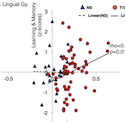Abstract
Sustained dysregulation of blood glucose (hyper- or hypoglycemia) associated with type 1 diabetes (T1D) has been linked to cognitive deficits and altered brain anatomy and connectivity. However, a significant gap remains with respect to how T1D affects spontaneous at-rest connectivity in young developing brains. Here, using a large multisite study, resting-state functional MRI data were examined in young children with T1D (n = 57; mean age = 7.88 years; 27 females) as compared with age-matched control subjects without diabetes (n = 26; mean age = 7.43 years; 14 females). Using both model-driven seed-based analysis and model-free independent component analysis and controlling for age, data acquisition site, and sex, converging results were obtained, suggesting increased connectivity in young children with T1D as compared with control subjects without diabetes. Further, increased connectivity in children with T1D was observed to be positively associated with cognitive functioning. The observed positive association of connectivity with cognitive functioning in T1D, without overall group differences in cognitive function, suggests a putative compensatory role of hyperintrinsic connectivity in the brain in children with this condition. Altogether, our study attempts to fill a critical gap in knowledge regarding how dysglycemia in T1D might affect the brain’s intrinsic connectivity at very young ages.
